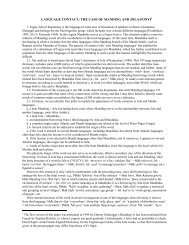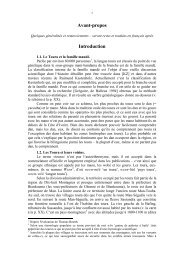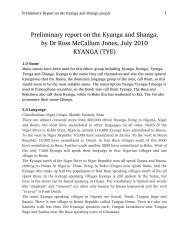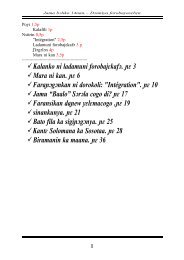unless there is a supplementary, more subtle conditioning. I reconstructfor this series *ɓ, but mark it with a question.? *ɓl antelope-2 > Tura # ɓ n bush duiker, Guro #, GR bl n redbushbock, Gban # b n antelope (sp.), Beng # bl n yellow-backed duiker? *ɓl big-1 > Mano ZE ɓl n human fat, Guro # bn adj big, large;important, Gban ST bl, Wan # ɓalè? *ɓ friend-3 > Mano NE, ZE ɓ, pl. -n, Guro # bēè, Yaure HP bȅè,bȅ `, Gban # bè n friend; friendship, Mwan # ɓ? *ɓ here-1 > Dan (bl, kl) ɓ pron. that; (bl) there, Dan (gw) ɓa, Tura #ɓ adv here (nearby), Guro VV b adv here (in a distance, but within visibility),Mwan ɓē here, there? *ɓèl viper > Dan (bl) ɓ, ɓ, ɓ, Dan (gw) ɓ, ɓ, ɓ, ɓl,Dan (kl) ɓl, Dan (yi) ɓl, Tura # ɓè, Mano VV ɓl, Guro #, BN, GRbl n naja, cobra, Yaure HO ɓùl, Mwan # ɓlùOne set seems to combine «irregular» changes in Guro (analyzed inthe current paragraph) and in Wan (see 3.2.3.1.):? *ɓ granary-3 > Guro # b n granary; hayloft, Wan # bē, Beng # bn granary (for corn or rice)3.2.3.4. There are several sets where initial p- emerges in some singlelanguages, while other languages have regular reflexes of *b-. So far, Ihave no reasonable explanation for these irregularities; it is more appropriateto consider them as unrelated forms:*b powder-4 > Dan (gw) b, Dan (bl) bia n powder; flour, Tura b npowder; flour, Mano ZE b, Gban # ȅ n ash; powder; flour, {Mwan PM p}*b grass-1 > Tura (n) b, Tura (w) bé, {Beng PA p n grasses; weeds}*ba rain (to) > Dan (bl) ba, Dan (kl) ba vi rain, Tura # ba vi fall hereand there; rain; pour; fall together; place oneself; vt make fall here and there; pour;put, Mano ZE ba vi rain, Mwan CF ba, {Wan # pa } Beng ba3.2.4. It is interesting to compare the results of my reconstruction withthe data of Claire Grégoire [Grégoire 1988]. In her work, <strong>South</strong> <strong>Mande</strong>was just one among many <strong>Mande</strong> branches to be compared, but she hasaffirmed repeatedly that the East <strong>Mande</strong> data may be decisive for thereconstruction of the proto-language of the entire family.Claire Grégoire singled out 8 labial «types», for each of which shereconstructed a Proto-<strong>Mande</strong> phoneme. Let us examine each of them.
Type I: *m. This series rises no questions; it should just be noted thatin Proto-<strong>South</strong> <strong>Mande</strong> it is not a separate phoneme, but a nasal allophoneof */ɓ/.Type II: *mb. Two of Claire's sets, 'to go out' and 'dumb', in my Proto-SM reconstruction have initial *ɓ- ('go out (to)' and 'mute-1', cf. 3.2.1.)rather than *b-. Her Guro forms b 'to look like' and bō(b)ō 'dumb' are mostprobably taken from the dissertation of H.-Cl. Grégoire (unfortunately,Claire does not provide the list of her data sources). 8 As for the Yaureform bura, it is certainly not genetically identical to the other forms for 'goout'; there is another form in this language, ɓɔ, which fits the set very well,especially if we take into account the polysemy of this verb in thelanguages of the group (and of other <strong>Mande</strong> languages as well).The third set, 'to cover', is represented in my data as *blŋ bury > Dan(bl) b hide, Tura # b, Mwan # bŋ, Wan # bla (?), Beng # bl, whichcorresponds more or less to Claire's data for <strong>South</strong> <strong>Mande</strong>. At the sametime, this set raises two serious problems.First, my Proto-SM form has *b-, unlike those for 'go out' and 'dumb',which is incompatible with their being put together in one «type».Second, I disagree with Claire as to the links of the stems in other<strong>Mande</strong> groups. For me, this stem corresponds to Soso br vt bury (animal,object), Mogofin biri vt bury, Nyokolo Maninka and Xasonka bùruu vtbury, Kankan Maninka br vt bury, Soninke bulu/bullu vt bury, dig in. Asfor the forms for Manding and many other West <strong>Mande</strong> languages providedby Claire, I consider them as a different stem 'bend-1', whose reflexesare as follows:Vai b' vi stumble; get caught (as in a trap)P.Manding *bDi(n), Mandinka bti vt shut, close; cover; finalizemarriage with, Nyokolo Maninka bidi vt cover, Xasonka búti vt cover withsth. (sth. – kùnna); vr bend down, curve; hide oneself, Kagoro VV bti vioverturn, come down; vt bend; turn over (vessel); cover with sth. (sth. – na); vrbend down, curve, Maninka bdi˜, bri˜, bdi vi fall prone; vt bend (one's back,head), curve, stoop; cover with sth. (sth. – l, k); sit on (eggs); vr bend down,stoop; lie face down, fall prone; n ambush, Bamana bri vi fall prone; overturn,come down (upon – k); vt bend (one's back, head), curve, stoop; turn over(vessel); cover with sth. (sth. – l, k); vr bend down, stoop; conceal oneself, skulk,lurk; lie face down, fall prone; lean backBobo plē/plē vi bend (of a vessel)8As was mentioned above, in this dissertation b and ɓ are often not distinguished.
- Page 2: necessary some serious corrections
- Page 7 and 8: 2. Phonological systems of the Sout
- Page 9 and 10: c) The phonological status of palat
- Page 11 and 12: 2.5. Yaure [Lautenschlager 1992].Co
- Page 13 and 14: Note: The phonological status of ll
- Page 15 and 16: question is: should we postulate tw
- Page 17 and 18: Series 2:SMande Dan Tura Mano Guro
- Page 19 and 20: 3.1.4. Series 4 and 5 differ only b
- Page 21 and 22: 3.2. Voiced and implosive labials3.
- Page 23 and 24: esemble (smb. - m); help (smb. - v)
- Page 25 and 26: *magólóŋ mango > Dan (bl) malo,
- Page 27 and 28: *bùò wake up-2 > Dan (bl) b vi, M
- Page 29: ? *ɓl respect-2 > Dan (bl) ɓl, Da
- Page 33 and 34: 2) for the same stem, the Mano form
- Page 35 and 36: *t red-1 > Dan (bh, yi) t, Dan (kl)
- Page 37 and 38: ? *tó chest-2 > Dan (gw, kl) # tȍ
- Page 39: VIII. Tagung der Vereinigung der Se
- Page 43 and 44: *ɗó leave (go away)-1 > Dan (bl,
- Page 45 and 46: *ɗŋ place-3 > Dan (bl) ɗ, Dan (g
- Page 47 and 48: uncle's wife, Mano ZE lèē, Mwan #
- Page 49 and 50: *s oilpalm grain-2 > Dan (bl) s n o
- Page 51 and 52: Series 20:SMande Dan Tura Mano Guro
- Page 53 and 54: *zèē here-2 > Dan (bl) z, Dan (gw
- Page 55 and 56: Series 24:SMande Dan Tura Mano Guro
- Page 57 and 58: *ka house-1 > Dan (bl, gw, kl) k, T
- Page 59 and 60: In the 'skin' set, the Kla-Dan form
- Page 61 and 62: *gŋ hill-2 > Dan (bl) gōō, Tura
- Page 63 and 64: (For further examples cf. series 29
- Page 65 and 66: ? *ƙùl round-2 > Dan (bn) gl, Dan
- Page 67 and 68: *gb baboon (Papio cynocephalus) > D
- Page 69 and 70: SMande Dan Tura Mano Guro Yaure Gba
- Page 71 and 72: of the types *kUlE, *kUlA, *kUE, *k
- Page 73 and 74: *y breast-3 > Dan (bl, gw, kl) y, T
- Page 75 and 76: SMande Dan Tura Mano Guro Yaure Gba
- Page 77 and 78: process may be reconstructed: *yl >
- Page 79 and 80: *wūō cry-1 > Guro ST wū, Guro BN
- Page 81 and 82:
*wōlō pick up > Dan (bl) lōō vt
- Page 83 and 84:
4. The reconstructed proto-SM syste
- Page 85 and 86:
Abbreviationsadj - adjectiveadv - a
- Page 87 and 88:
Flik 1977Flik, Eva. Tone glides and
- Page 89 and 90:
Prost 1950/1968Prost 1953Prost Ms.R









